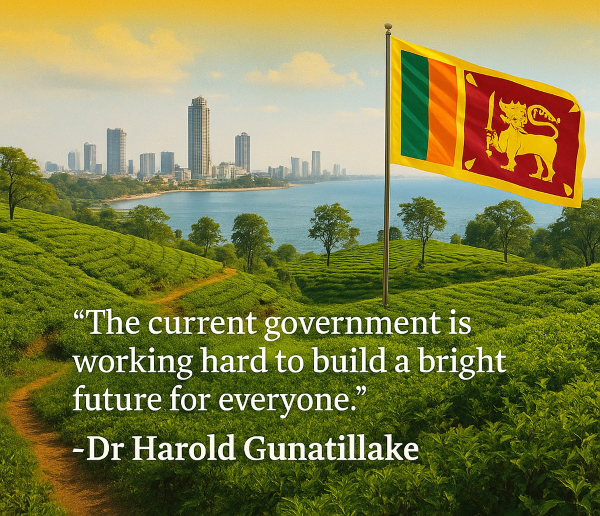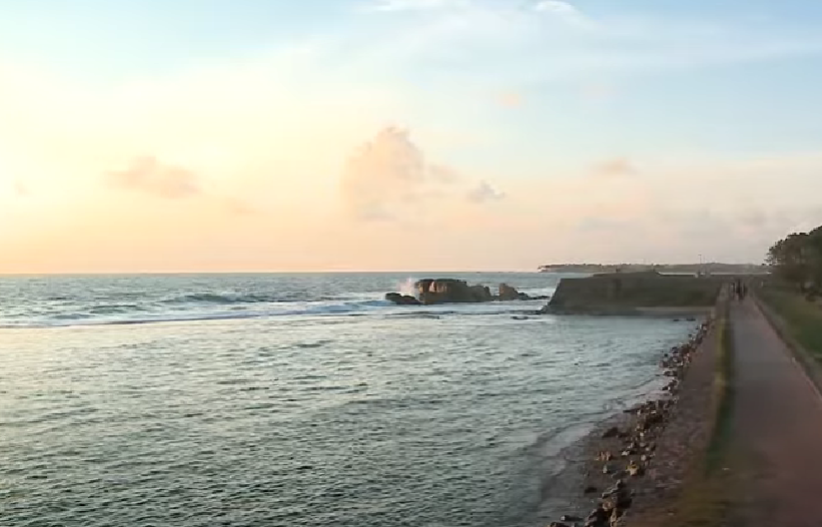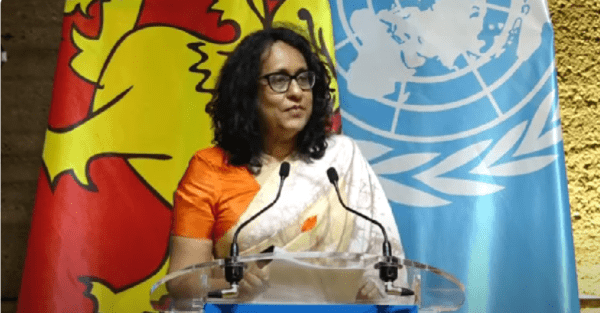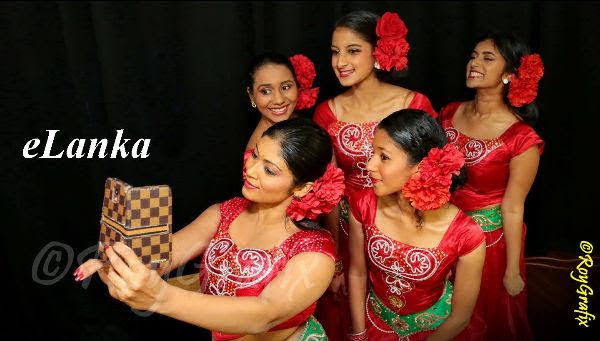HIDDEN FACTS ABOUT OUR SOLAR FESTIVAL
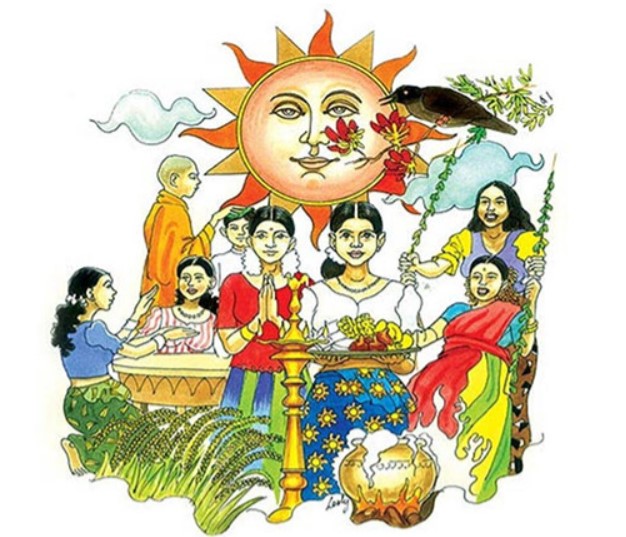
Source:Island
Geographical factors prepare the agrobase while astrological factors determine the time-frame of our annual Solar Festival.
 As prominence given to more mundane things has held sway over our annual solar festival, popularly known as ‘aluth avurudda’, (and loosely referred to as the Sinhala-Tamil New Year), most of us little know or have not given sufficient thought to how this unique phenomenon has evolved over the years. Hence, although several weeks have elapsed since the dawn of the solar festival in mid-April this year, ruminating on its evolution and development thus far cannot be confined to a particular month or a few days of the year, although it is the culmination that reaches in mid-April. Even a cursory glance through its occurrence (recurrence!) shows that the dawning and waning of this nostalgic-event are spread over the whole year, and that it’s not a spontaneous activity. Even a rudimentary glance through the cyclic nature of this event shows that it’s the outcome of the interplay of several repetitive happenings basically influenced by geographical and astrological determinants.
As prominence given to more mundane things has held sway over our annual solar festival, popularly known as ‘aluth avurudda’, (and loosely referred to as the Sinhala-Tamil New Year), most of us little know or have not given sufficient thought to how this unique phenomenon has evolved over the years. Hence, although several weeks have elapsed since the dawn of the solar festival in mid-April this year, ruminating on its evolution and development thus far cannot be confined to a particular month or a few days of the year, although it is the culmination that reaches in mid-April. Even a cursory glance through its occurrence (recurrence!) shows that the dawning and waning of this nostalgic-event are spread over the whole year, and that it’s not a spontaneous activity. Even a rudimentary glance through the cyclic nature of this event shows that it’s the outcome of the interplay of several repetitive happenings basically influenced by geographical and astrological determinants.
Geographical Determinants
(i) Solar Festival Coinciding with the Vernal Equinox
When discussing the geographical determinants of our solar festival, the two events that we need to lay emphasis are the two major events coinciding with the (virtual) movement of the sun. The sun crosses the celestial equator twice a year. When the sun crosses the celestial equator in its northward journey up to the tropic of Cancer, it is referred to as the vernal equinox. Its timing is March 20/21. This is the commencement of the astronomical spring and summer for the northern hemisphere. It takes three months to reach the northern limit, that is, the tropic of Cancer (23.5 degrees from the equator), and its timing is June 20/21. In the sun’s return journey southwards it again crosses the celestial equator on September 20/2, referred to as the autumnal equinox. This event heralds the dawn of summer for the southern hemisphere. Thereupon, the sun journeys up to the tropic of Capricorn , that is, to its southern limit, on December 20/21. This limit too is 23.5 degrees away from the celestial equator.
(ii) Positioning of Sri Lanka vis-à-vis the sun’s upward – downward journeys
Against this backdrop what is relevant to our discussion on the solar festival is the positioning of Sri Lanka vis-à-vis the aforesaid journey of the sun. Sri Lanka is
approximately 7/8 degrees north of the celestial equator. Therefore, when the sun is over Sri Lanka in its northward journey it will be 23/24 days after the vernal equinox.
90 days – 23 days = 67 x 2 (up & down) = 134 days = Approx. 4 ½ months (Yala)
Its timing, therefore, coincides with April 14/15, on which date we celebrate the solar festival. From there onwards the sun takes approx.. 66/67 days to reach the tropic of Cancer, and for the sun to be over Sri Lanka again, in its southward journey, it takes another 66/67 days. So the sun’s movement from being over the island and back again to be over the island will take approximately 134/135 days or 4 ½ months.
(iii) The Yala – Maha Seasons and their impact on the Solar Festival
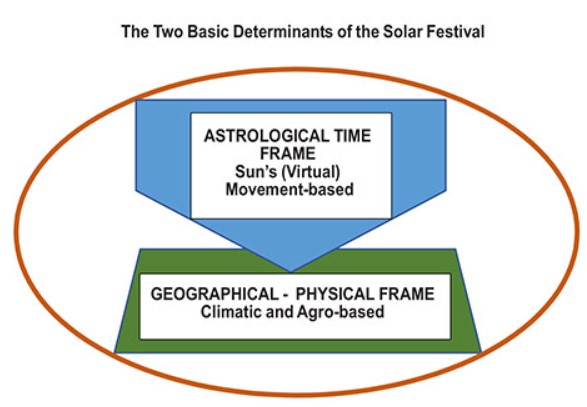 Due to Sri Lanka’s positioning nearly 8 degrees north of the equator, we saw that the sun in its northward journey, would be over the island on April 14/15. Again in its southward journey to the autumnal equinox the sun would be over Sri Lanka on August 26/27. The sun’s journey to the tropic of Cancer, from being over Sri Lanka and to be back to be on Sri Lanka would take 133/134 days or nearly 4 ½ months; that is, on the basis of 67 days of the sun’s upward journey from Sri Lanka to the tropic of Cancer and again it be over Sri Lanka in its backward journey. This shorter period of 4 ½ months is the Yala season or the ‘lesser harvest period. Invariably, therefore, the Maha season is the longer period of 7 ½ months, which is considered the principal or the main harvesting period.
Due to Sri Lanka’s positioning nearly 8 degrees north of the equator, we saw that the sun in its northward journey, would be over the island on April 14/15. Again in its southward journey to the autumnal equinox the sun would be over Sri Lanka on August 26/27. The sun’s journey to the tropic of Cancer, from being over Sri Lanka and to be back to be on Sri Lanka would take 133/134 days or nearly 4 ½ months; that is, on the basis of 67 days of the sun’s upward journey from Sri Lanka to the tropic of Cancer and again it be over Sri Lanka in its backward journey. This shorter period of 4 ½ months is the Yala season or the ‘lesser harvest period. Invariably, therefore, the Maha season is the longer period of 7 ½ months, which is considered the principal or the main harvesting period.
(iv) Why the Solar Festival cooinconicides with the end of the Maha Seasons –
Lexilogical Evidence
This determination would drive home the fact that while the Yala season in the island is shorter, the Maha season enjoys a wider spread of about 7 ½ months, vis-à-vis the total period of 12 months. Our Solar Festival is at the end of the Maha season, which provides a bountiful harvest during the month of Medin. The word Maha comes from Mas which is a combination of Maha+As (large+harvest). The month of Medin is what you get by combining Maha+Din. Maha is great/large or bountiful, and Din is reaping / cutting or harvesting. The oldest reference to the word din is in the Dhampiya Atuwa Getapadaya, inferred to have been written by king Kassapa V (Aba Salamevan Kasub) of the Anuradhapura period, that is, inor around the 10th century AD. Din also appears in the same context in several other subsequent literary works, namely, Amavatura and Ruwan Mal Niganduwa (a lexicon of the Kotte period).
The month coinciding with the Solar Festival is known as Bak Maha (month of Bak). It follows the month of medin. Hence, it needs no explanation that with the advent of the month of bak the country will be richer with a bountiful harvest gathered in the month of medin. The month of Bak (bhagya in Sanskrit for fortunate) thus becomes a propsperous – bountiful month as a result of the long period of agricultural pursuits under the Maha season, and the bountiful harvests gathered thereof in the month of Medin.
Astrological Determinants
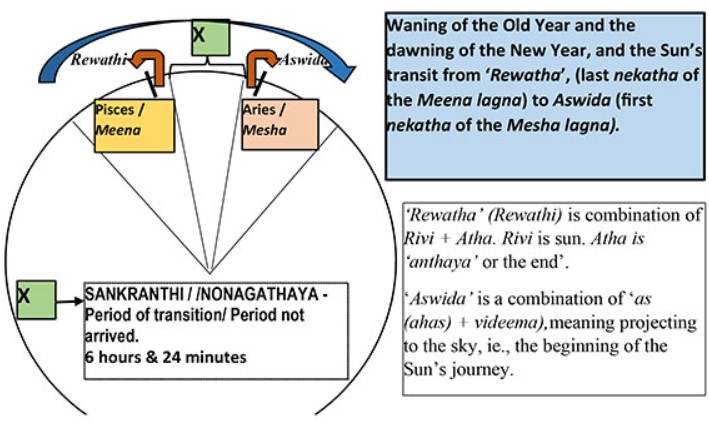 While geographical determinants set the groundwork for the staging of our solar festival, astrological determinants help fine-tuning the exactitudes as to what, how and when the gamut of related activites has to be performed. As to when the application of astrology to our routine and special activities commenced remains in obscurity. But the fact remains that timing is everything in our society, and shows how pervasive astrology has been in the Sri Lankan society. The success of something is often related
While geographical determinants set the groundwork for the staging of our solar festival, astrological determinants help fine-tuning the exactitudes as to what, how and when the gamut of related activites has to be performed. As to when the application of astrology to our routine and special activities commenced remains in obscurity. But the fact remains that timing is everything in our society, and shows how pervasive astrology has been in the Sri Lankan society. The success of something is often related
to when it happens. The astrological chart linked to the solar festival, therefore, plays a major role in determining the numerous activities linked to the Solar Festival, ranging from the waning of the Old-Year to the dawning of the New Year. There are three important phases in the sun’s transit from the old year to the new year. These are (i) The tail end of the old year referred to as ‘parana-avurudda’, (ii) The period of transition, referred to as ‘sankranthi’ (a Sanskrit word) or ‘nonagathaya’ (the period yet to arrive or the period un-arrived), and (iii) aluth avurudda (dawn of the new year).
‘Nonagathaya’ (the period not arrived/un-arrived) is an interesting word that gives a clue in an attempt to trace the history of the traditions of the solar festival. This word is derived from the combination of na + agatha. agatha is a past participle that appears commonly in many rock inscriptions including that of Vessagiri, belonging to the 6th century A.D. (of the early Anuradhapura period). One of its inscriptions says:
“dhamarakitha thera Agatha anagatha chathudisha shagasha dine.
anikata sona pithaha bariya upasika thisaya lene”.
(could be translated as “The rock cave donated to Dhammarakkhitha thero and sangha or fraternity who came from the four directions. This is the rock cave of female devotee Tissa, wife of Anekatta Sona’s father.)
Entry of Religious Observances, Customs, Rituals and Festivities
It is pretty obvious that, with the passage of time any human activity would grow in size
with the entry of beliefs, rituals, customs and festivities. They also provide a fertile springboard for the sprouting of faith-related activities. With the phasing out of the of
the total event into old year, interim phase and the new year a whole hog of things found their way into the system. Leaving aside the avurudu sports, festivities and community-activities, this is how such observances and customs as listed herein came in: (i) Bathing for the passing year, (ii) Cleaning and kindling the hearth, (iii) Boiling the milk-pot, (iv) Preparing the first meal, (v) Waring a particular coloured costume, (vi) Exchanging pleasantries, (vii) Partaking the first meal, (viii) Transacting with the well and with family members, including planting of a tree (ix) Visiting relatives and friends (x) Bathing (purification) for the newly dawned year, and (xi) Leaving home for diurnal activities. Each of the more important rituals and observances was guided by an astrologically determined auspicious time.
Nonagathaya (un-arrived time) and Religious Activities
Among the different phases of the solar festival much importance was give to
‘nonagathaya’ or the un-arrived time. During this time, according to tradition the Sri
Lankans have been encouraged to refrain from material pursuits, and engage solely in
religious activities. This is the period the sun is said to be transiting from rewathi nekata of the Meena rashi (Pisces) to aswida nekatha of the Mesha rashi (Aries). Astrologically this span of about 6 ½ hours isn’t result bearing period, and therefore, the people have been, for ages, bent on religious practices. Some have dared to refer to nonagathaya as an inauspicious time.
Commonality of Our Solar Festival with those of Our neighbours
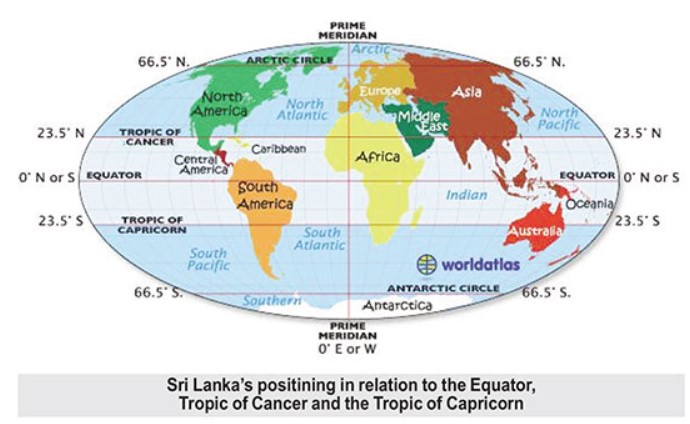 Probing into the festivals of our neighbouring countries reveals that their national festivals also coincide with our solar festival. This revelation enables reaching the obvious conclusion that wherever agricultural pursuits had been their main stay, the sun played a decisive role in determining their activities. The national holidays referred to as Songkran in Thailand also falls on April 13, and goes on for three days up to April 15. Songkran is derived from the Sanskrit word sankranthi. They also believe in the sun’s transiting, which is specifically referred to as meṣha saṅkrānti. In Thailand event has lately been transformed as the National Water Festival, highlighting the impact of water on their daily pursuits. The geographical spread of the solar festival also establishes the impact of the Hindu calendar and the influence of the Sanskrit language on their civilizations. It also reveals that the traditional solar-based New Year is celebrated in Laos, Cambodia, Myanmar, Bangladesh, Nepal, Mauritius, some parts of northeast India, parts of Vietnam and China as well. The timing of these festivals is almost similar. All these countries including Sri Lanka had been following the Solar Calendar until the advent of the Gregorian Calendar. The Silappadikaram of the 5th century, an elaborate poetic interpretation of Tamil culture mentions the 12 Raasis or zodiac signs that correspond to the Tamil months starting with Mesha/Chitterai (Aries) in mid-April.
Probing into the festivals of our neighbouring countries reveals that their national festivals also coincide with our solar festival. This revelation enables reaching the obvious conclusion that wherever agricultural pursuits had been their main stay, the sun played a decisive role in determining their activities. The national holidays referred to as Songkran in Thailand also falls on April 13, and goes on for three days up to April 15. Songkran is derived from the Sanskrit word sankranthi. They also believe in the sun’s transiting, which is specifically referred to as meṣha saṅkrānti. In Thailand event has lately been transformed as the National Water Festival, highlighting the impact of water on their daily pursuits. The geographical spread of the solar festival also establishes the impact of the Hindu calendar and the influence of the Sanskrit language on their civilizations. It also reveals that the traditional solar-based New Year is celebrated in Laos, Cambodia, Myanmar, Bangladesh, Nepal, Mauritius, some parts of northeast India, parts of Vietnam and China as well. The timing of these festivals is almost similar. All these countries including Sri Lanka had been following the Solar Calendar until the advent of the Gregorian Calendar. The Silappadikaram of the 5th century, an elaborate poetic interpretation of Tamil culture mentions the 12 Raasis or zodiac signs that correspond to the Tamil months starting with Mesha/Chitterai (Aries) in mid-April.
Conclusion – The Sun, the First Time-keeper to the Nation
Hence, the above revelations compel us to conclude that our solar festival is more than just a solar experience. As it is intensively interwoven with the habits of the people, it is a festival that celebrates Sri Lankan culture, history, and science. In fact, the sun has been our first time-keeper to the nation. Greek culture was referred to as the Hellenistic culture as they were worshippers of the sun. Helio is the sun. Our ancestors were also worshippers of the sun, and they were also referred to as Helas. It is the four Hela clans (Yak, Na, Dev, Rakus) that later became siv+hela and ultimately Sinhala. Heli helei heleyya… a song that continues to be sung by our fisher-folk is a strong indication of our closeness with the sun. There’s hardly any doubt, therefore, that our solar festival goes back to unrecorded prehistoric times.
Note:
It needs to extend a word of appreciation to Prof. Ajantha S. Dharmasiri for providing the writer an opportunity to research and make a presentation on our Solar Festival to the Institute’s staff.



